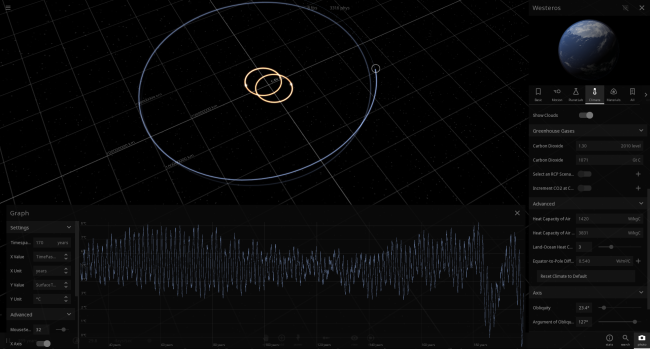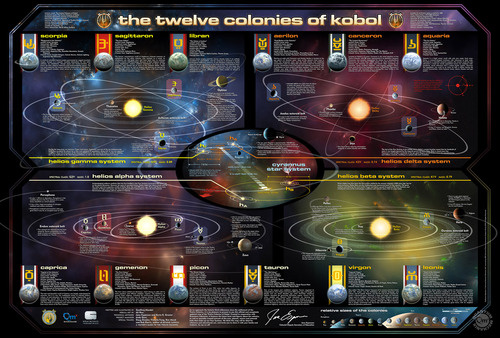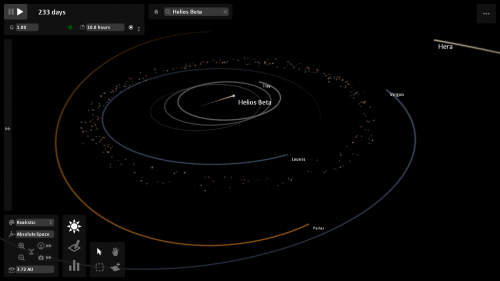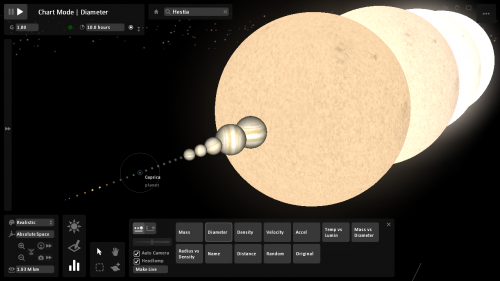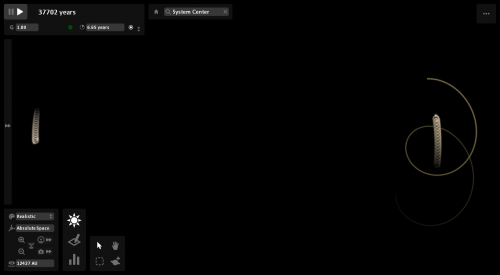Fiction
Simulating the World of Game of Thrones in Universe Sandbox ²
Jul 17th
An Unpredictably Long Winter is Coming
Fans of George R. R. Martin’s fantasy series A Song of Ice and Fire or the television series, Game of Thrones, know well the often repeated warning, “Winter is coming.”
For those living on the continent of Westeros in this fantasy world, summers can be long, and so can the winters. But some winters are especially cold and last for several years, while others are relatively mild and short.
What causes this variance in seasons? Martin doesn’t offer an explanation, so we’re free to speculate.
One research paper (“Winter is coming”) proposes that perhaps there’s a natural explanation: Westeros is on a circumbinary planet, meaning its orbit extends around a binary star system.
Simulating Westeros in Universe Sandbox ²
The paper may be tongue-in-cheek, but that doesn’t mean we can’t use its parameters to try simulating it in Universe Sandbox ². Like the paper, we were unable to find stable orbital parameters that would create the level of unpredictability discussed in the books or the show.
We could, however, create a system that has variable winter and summer intensities on regular predictable intervals with a large northern polar ice region. Though our results didn’t exactly match those in the paper, we managed to recreate similar seasonal patterns to what the authors describe in their paper.
If you own Universe Sandbox ², you can see this simulation for yourself in Alpha 15: Home -> Open -> Fiction -> Lands of Ice & Fire | Game of Thrones.
To open the temperature graph, open the Westeros planet’s Properties, select the Climate tab, hover over the Surface Temperature icon and click the Graph button.
If you don’t own Universe Sandbox ², you can buy it now to get instant access to the alpha via Steam code: http://universesandbox.com/2
Twelve Colonies
Jan 28th
Earlier today I saw Bad Astronomy’s post about a Twelve Colonies map created by one of the writers and the science advisor for the new Battlestar Galactica series. I’m a big fan and always wondered how all the different colonies mentioned in the show related to one another.
I forwarded the link to a good friend (who I introduced to the series) and mentioned how this would make an excellent Universe Sandbox simulation (since there was so much data about sizes and distances). She emailed back with the encouragement to make and post it today so I spent the rest of the day creating a Universe Sandbox simulation of the Twelve Colonies of Kobol.
Open the Twelve Colonies simulation on your computer
- Download & Install Universe Sandbox (it’s free and includes a 60 minute trial of all the premium features)
You may want to run through the short tutorial to get a feel for how to navigate in the simulator. - Download the Twelve Colonies Simulation.
- Open the simulation by either dragging the downloaded file into the Universe Sandbox window or by double clicking on it.
This mathematically accurate simulation of the 4 stars and 12 colonies can be viewed with either the Free or Premium version of Universe Sandbox 2.
Here’s a screenshot from Universe Sandbox of the Helios Beta system (the star system in the lower right corner of the above map):
Here’s how Caprica stacks up in comparison to the other planets and the four stars:
Just click the Chart Mode button to see this view for yourself. It looks like this:
![]()
Simulation Features
- Each pair of star orbits each other and the two sets also orbit each other (around their barycenter).
- Caprica and Gemenon orbit their barycenter which is in orbit around Helios Alpha.
- Aerilon and Canceron are at the L4 and L5 point of Delta and Hestia.
Simulation Notes
- Star masses from the map were assumed to be relative to our real Sun.
- All colony planets were hand placed within each stars habitable zone (a feature in Universe Sandbox).
- I had to move Ragnar out by another 800 SU/AU in order for its orbit around the barycenter of Delta and Gamma to be stable.
- If you run the simulation at a fast time step the planets will get thrown out, but it will show how the stars orbit each other.
- No moons are included in this version.
- All the colonies are using the same planet texture. (A planned update to Universe Sandbox will address the lack of texture variety.)
- The ubox simulation file is fully editable using the built-in file tools in Universe Sandbox.
More info
- io9’s post with interview of the map creators
- Bad Astronomy’s post about the map
- Wikipedia Article on the Twelve Colonies
And a final screenshot that shows how the stars are all orbiting each other:
The stars Alpha and Beta are orbiting each other on the left and Gamma and Delta are on the right. The other larger spiral is the Ragnar planet that orbits the barycenter of Gamma and Delta. To create this shot I deleted all the planets (save Ragnar), increased the time step, and lengthened the trails. This is showing the extent of the entire simulation as shown in the center of the original star map.
City on Caterpillar Tracks
Feb 28th
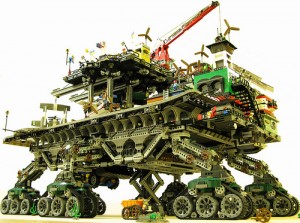 This has nothing to do with astronomy or Universe Sandbox, but as a LEGO fan, I’m incredibly inspired by this creation:
This has nothing to do with astronomy or Universe Sandbox, but as a LEGO fan, I’m incredibly inspired by this creation:
http://www.brothers-brick.com/2010/02/19/crawler-town-brings-the-city-to-you/
Which seems to be directly inspired by fictional Traction Cities from Philip Reeve’s Mortal Engines Quartet series of books:
http://en.wikipedia.org/wiki/Traction_City
I think the idea of massive, movable cities is fascinating to think about.
Source: Brother’s Brick, an excellent LEGO blog.

